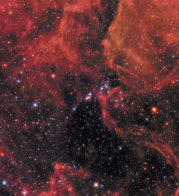
Image credit: Borexino collaboration.
The international Borexino collaboration has released results from a new measurement of geoneutrinos corresponding to 1352.60 live days and about 187 tonnes of liquid scintillator after all selection criteria have been applied (3.7 × 1031 proton × year). This corresponds to a 2.4 times higher exposure with respect to the measurement made in 2010.
Borexino is a liquid-scintillator detector built principally underground at INFN Gran Sasso National Laboratory in central Italy to detect solar neutrinos. However, because of its high level of radiopurity – unmatched elsewhere in the world – it can also detect rare events such as the interactions of geoneutrinos. These are electron-antineutrinos that are produced in the decays of long lived radioactive elements (40K, 238U and 232Th) in the Earth’s interior.
From the data collected, 46 electron-antineutrino candidates have been found, about 30% of them geoneutrinos. Borexino has also detected electron-antineutrinos from nuclear power plants around the world. These latter antineutrinos give a signal of about 31 events, which is in good agreement with the number expected from the 446 nuclear cores operating during the period of interest (December 2007 to August 2012) and from current knowledge of the parameters of neutrino oscillations. The total expected background for electron-antineutrinos in Borexino is determined to be about 0.7 events. The small background is a result of the high level of radiopurity of the liquid scintillator. For the current measurement, the null geoneutrino hypothesis has a probability of 6 × 10–6.
The detection of geoneutrinos offers a unique tool to probe uranium and thorium abundances within the mantle. By considering the contribution from the local crust (around the Gran Sasso region) and the rest of the crust to the geoneutrino signal, the signal from the radioactivity of uranium and thorium in the mantle can be extracted. The latest results from Borexino, together with the measurement by the KamLAND experiment in Japan, indicate a signal from the mantle of 14.1±8.1 TNU (1 TNU = 1 event/year/1032 protons).
These new results mark a breakthrough in the comprehension of the origin and thermal evolution of the Earth. The good agreement between the ratios of thorium to uranium determined from geoneutrino signals and the value obtained from chondritic meteorites has fundamental implications for cosmochemical models and the processes of planetary formation in the early Solar System.
By measuring the geoneutrino flux at the surface, the contribution of radioactive elements to the Earth’s heat budget can be explored. The radiogenic heat is of great interest for understanding a number of geophysical processes, such as mantle convection and plate tectonics. For the first time two independent geoneutrino detectors – Borexino and KamLAND, which are placed in different sites around the planet – are providing the same constraints on the radiogenic heat power of the Earth set by the decays of uranium and thorium. With these latest results, the Borexino collaboration finds that the data fit to a possible georeactor with an upper limit on the output power of 4.5 TW at 95% confidence level.
Further reading
G Bellini et al. Borexino collaboration 2013 arXiv:1303.2571 [hep-ex].





